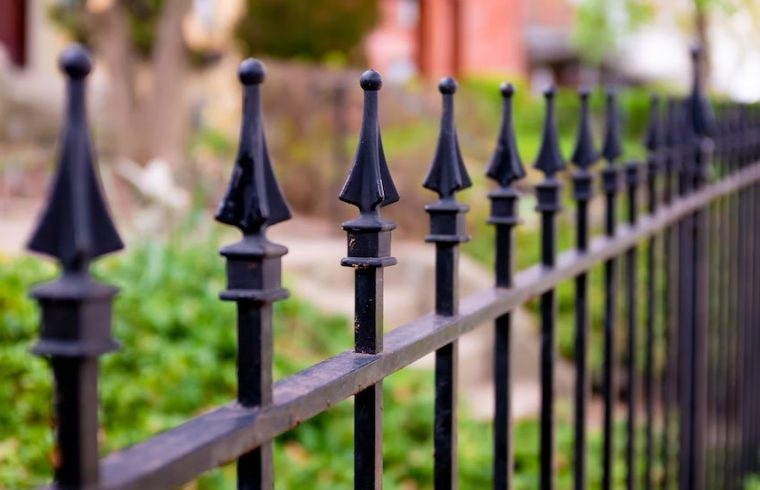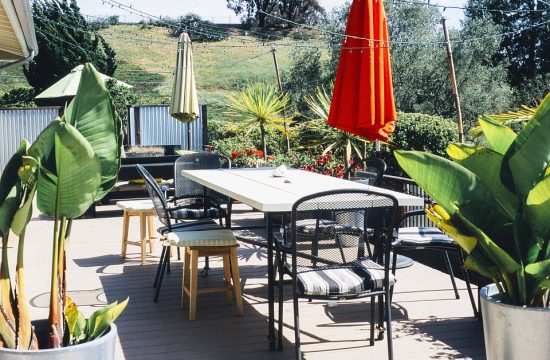Lubricate the hinges and wheels regularly
Maintaining the moving parts of the fence, such as the hinges and wheels, is crucial to maintaining optimal performance and preventing rust. Lubricating these components regularly ensures the fence opens and closes smoothly without squeaking and provides additional protection against corrosion.
A thin layer of lubricating or used oil can form on the surfaces of hinges and wheels. This layer acts as a barrier between iron and the two main elements that cause corrosion: water and oxygen. Therefore, it is recommended that you lubricate the hinges and wheels of your fence every two to three months or immediately when you hear squeaking noises. Performing this maintenance can extend the lifespan of moving components and maintain the gate’s overall functionality.
Following these steps will ensure that your iron fence continues to operate optimally and avoid damage caused by rust on vital parts. Regular and proper maintenance is essential to ensure that your fence functions well and has a long lifespan.
Avoid water puddles around the fence
Water accumulation around the base of iron fences, especially from rain, is one of the main causes of corrosion that is often overlooked. The lower part of the fence is constantly damp due to the accumulation of water, creating highly conducive conditions for rust. To prevent this, ensure the drainage system around the fence is functioning properly to prevent areas where water can accumulate for long periods. A smooth-flowing drainage system will direct rainwater away from the fence.
Let’s raise the area around the base of the fence so that it does not come into direct contact with wet soil. Additionally, wipe down any wet parts of the fence after heavy rain to prevent water from pooling. Taking these steps will significantly reduce the fence’s exposure to excessive moisture. This will minimize the risk of corrosion and extend the fence’s lifespan.
Consider using additional coatings such as galvanization or chromium
To ensure long-term protection, consider applying additional coatings, such as galvanization or chromium. Galvanization involves covering the surface of iron with zinc, a technique that has been proven to effectively prevent corrosion.
This process is usually done using the hot-dip galvanizing method, in which iron is immersed in molten zinc. The zinc coating then acts as a protective layer against oxidation, effectively preventing rust from forming on the iron surface. Chromium plating is also an excellent choice. Chromium forms a protective layer that is highly resistant to water and oxygen. It also gives iron an attractive shine, making it more aesthetically pleasing and durable.
These coating methods offer better protection against corrosion than regular paint. Therefore, investing in these coatings is valuable for maintaining the quality and beauty of your iron fence.
Apply a corrosion inhibitor
Corrosion inhibitors are chemical compounds designed to prevent rust on metal surfaces. They can be applied in various ways, such as a base coat before painting or directly on metal parts showing early signs of rust.
Once applied, the inhibitors form a protective layer on the iron’s surface. This layer interferes with the chemical reactions that cause corrosion, protecting the iron from further damage. Therefore, it is important to apply the inhibitor evenly across the entire surface of the fence to maximize its effectiveness.
To maintain effectiveness, apply the inhibitor periodically according to the product instructions. In this way, corrosion inhibitors can be an effective part of your iron fence maintenance strategy, ensuring that your fence remains rust-free and durable for a long time.
Protect Your Fence from Extreme Weather
One of the main causes of accelerated damage to iron fences is extreme weather. Heavy rain, intense sunlight, and significant temperature fluctuations can damage the paint coating and speed up corrosion. Sunlight’s UV rays can cause paint to fade and peel, while high rainfall and excessive humidity increase the likelihood of rust. While it is difficult to protect fences completely from the elements, preventive measures can be taken to reduce their impact.
One wise step is to choose high-quality paint with anti-UV features that can withstand various weather conditions. It is also important to address any minor paint damage caused by extreme weather immediately. This proactive maintenance will help maintain the integrity of the protective coating on your iron fence, ensuring it lasts longer even when exposed to bad weather. Taking these steps ensures that your iron fence remains in good condition and functions optimally.
Perform regular professional maintenance
While you can perform basic maintenance yourself, it is still recommended that you call a professional periodically. Professionals have the special tools and materials necessary to thoroughly clean, repair, and coat your fence.
Conduct a thorough inspection with a technician once a year to ensure that no parts are overlooked. This is especially important for iron fences that are more than five years old. With professional maintenance, your iron fence can remain sturdy, clean, and rust-free for decades.
–sh












